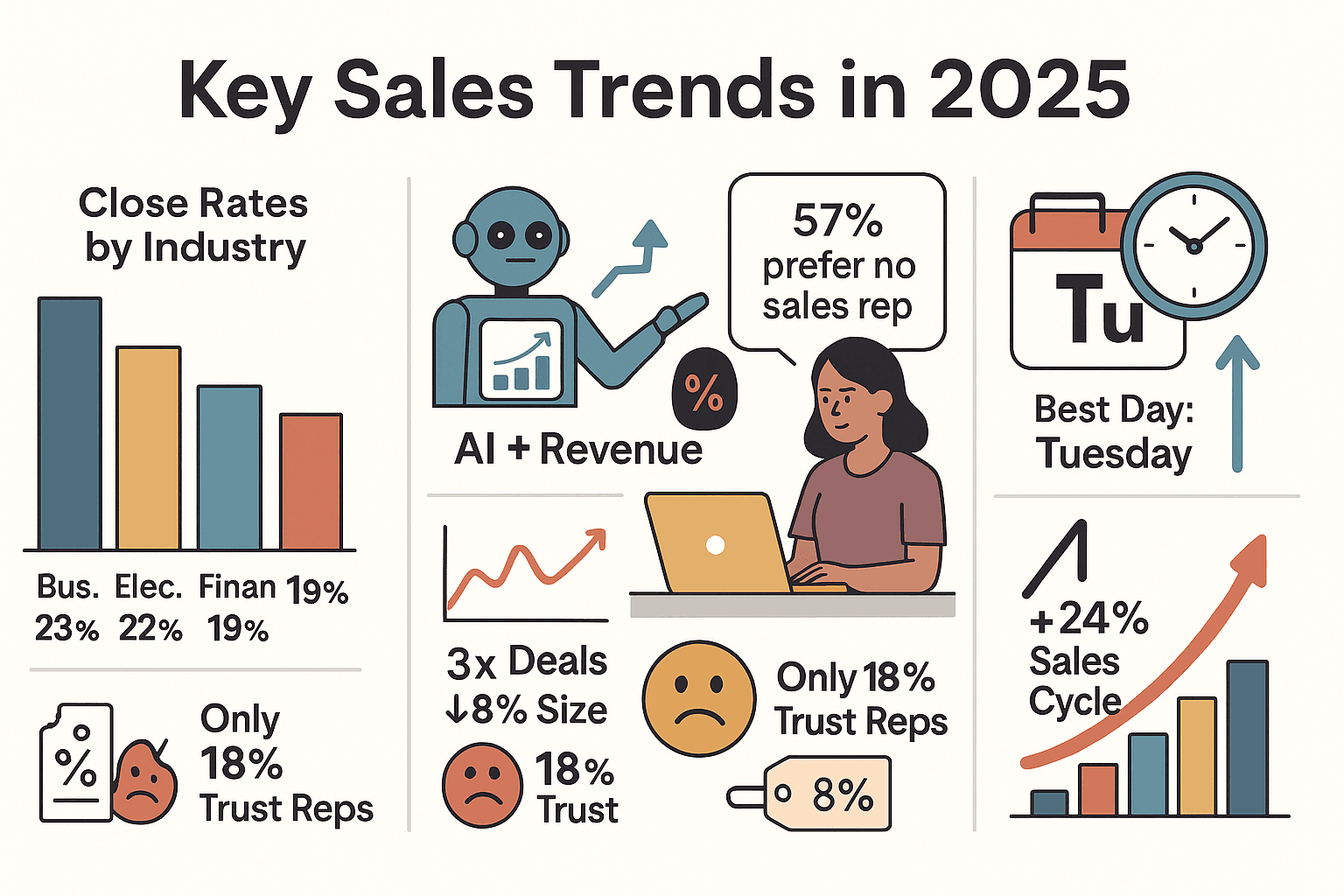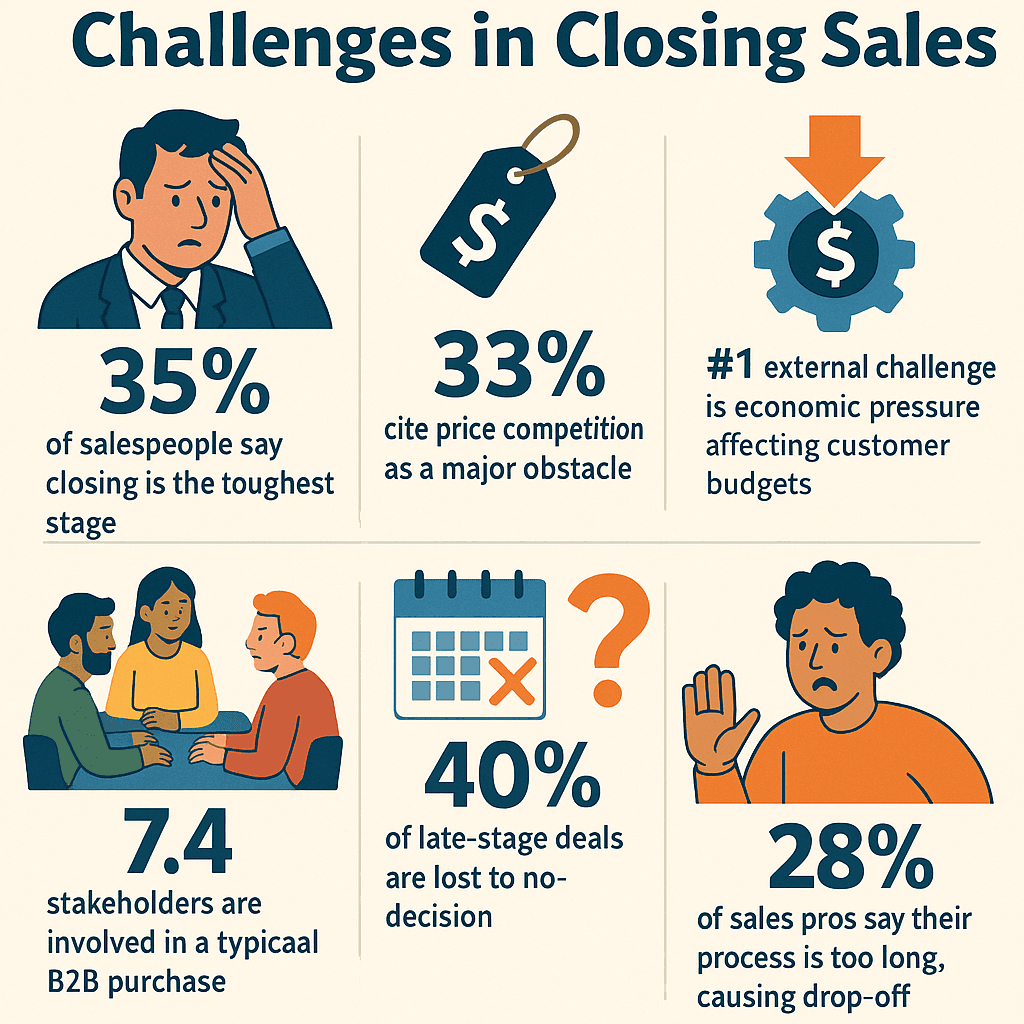Picture this: It’s the last week of the quarter. Your sales team is hunched over laptops, coffee cups everywhere, and the Slack notifications are flying. Everyone’s chasing that final deal to hit quota. But what if you could stop guessing and actually know which deals are likely to close, when to reach out, and what’s really holding buyers back? That’s the power of sales statistics in 2025—turning gut feelings into data-driven wins.
In this guide, I’ll walk you through the 40 most essential sales closing statistics for 2025. Every stat here was sourced using (yes, the tool my team and I built to make sales research less “needle in a haystack” and more “data at your fingertips”). Whether you’re a sales leader, a marketer, or just someone who loves a good spreadsheet, these numbers will help you sharpen your strategy, boost your close rates, and maybe even reclaim your weekends. Let’s dive in.
Quick-Glance: 10 Headline Sales Closing Statistics for 2025

- Average Close Rate: The typical sales close rate across industries is around —only one in five prospects becomes a customer.
- Industry Variance: Close rates differ by sector—, , , and .
- Sales Cycles Are Longer: The average startup saw a (from ~60 to 75 days) in the last year.
- AI Adoption: now use or experiment with AI, and vs. 66% without AI.
- End-of-Month Surge: Salespeople close , but due to last-minute discounts.
- Best Day to Close: is the best day for sales success—close rates are nearly than average.
- Best Time of Day: Calls between have a of success.
- Buyers Going Rep-Less: believe buyers depend less on sales reps than a few years ago; would prefer a rep-free experience.
- Low Trust in Sales Reps: Only believe a salesperson who says “We’re here to help.”
- Customer Experience is King: say the experience a company provides is as important as its products/services—and for a great experience.
Why Sales Closing Statistics Matter in 2025
Let’s be honest: Sales in 2025 isn’t for the faint of heart. Buyers are more informed, competition is relentless, and quotas seem to be set by someone who thinks “stretch goal” means “impossible.” In this environment, relying on intuition alone is like bringing a butter knife to a sword fight.
Sales closing statistics aren’t just trivia—they’re your GPS for navigating a complex landscape. Data-driven teams are and . With , knowing your numbers is the difference between hitting targets and missing out.
That’s where comes in. Instead of spending days combing through endless reports, Thunderbit lets you gather and analyze up-to-the-minute sales data in minutes. I’ve seen firsthand how real-time insights can transform a team’s approach—no more flying blind, just actionable intelligence.
Sales Closing Rates: What the Numbers Reveal
Industry Benchmarks for Sales Closing Rates
Sales closing rates are the ultimate scoreboard. But what’s “good” depends on your arena:
Outside sales reps (think big-ticket, face-to-face deals) close at around , while inside sales (phone, email, web) average . So, before you panic about your numbers, make sure you’re comparing apples to apples.
Trends Over Time
Is closing getting easier? Not exactly. —double last year’s number. Economic headwinds, more decision-makers, and longer cycles mean you need more touches (and more patience) to get to “yes.”
Factors Influencing Close Rates
Why do some deals close and others stall? Here’s what the data says:
- Speed Wins: . Respond fast, or risk losing out.
- Persistence Pays: , but . Don’t be that rep.
- Ask for the Close: . Sometimes, all you have to do is ask.
- Personalization Matters: ), and .
- Trust and Rapport: Only . Building credibility is a must.
- Communication Tactics: Overusing words like “discount” can . Use confident, collaborative language instead.
Timing Is Everything: When Deals Are Most Likely to Close
Best Days and Times for Closing Sales
Not all hours (or days) are created equal in sales:
- Tuesday is the MVP: Outreach on than average. Monday and Thursday are solid runners-up. Avoid Friday if you can—buyers are already thinking about their weekend plans.
- Morning Wins: Calls between have a . Overall, mornings are than afternoons.
Pro tip: Schedule your “big ask” for Tuesday morning. Save Friday afternoons for paperwork or, better yet, an early happy hour.
End-of-Month and Quarter Effects
- Deal Volume Spikes: Salespeople close .
- But at a Cost: at month’s end due to discounts.
- Sandbagging Is Real: Reps sometimes delay deals to boost next quarter’s numbers, which can .
If you’re a sales manager, consider incentives to spread deals more evenly—and maybe keep the team from turning into discount superheroes at the end of every month.
Buyer Behavior: How Customers Make Closing Decisions
Trust and Communication in the Sales Process
- Trust Gap: Only .
- Referrals Rule: ).
- Buyers Want Honesty: builds trust.
- Social Proof Matters: to support purchase decisions.
Actionable takeaway: Use referrals, be transparent, and don’t oversell. If you can make a prospect laugh, even better—top reps are .
The Rise of Self-Service and Digital Research
- .
- .
- .
- before engaging sales.
What does this mean for sales teams? Your website, content, and digital presence are now your frontline closers. By the time a buyer talks to you, they’re already halfway down the funnel—so be ready to add value, not just repeat what’s on your homepage.
Technology’s Impact: Sales Closing Statistics in the Digital Era
AI and Automation in Sales Closing
- ; .
- .
- , .
- .
As someone who’s spent years building automation tools, I can tell you: AI isn’t here to replace salespeople—it’s here to make you superhuman. (Or at least, free you from chasing down that one missing contract signature.)
Virtual Selling and Remote Closing Trends
- .
- .
- .
Remote closing isn’t just a pandemic blip—it’s the new normal. If you’re still waiting for that steak dinner handshake, you might be waiting a while.
Overcoming Sales Closing Challenges: What the Data Says
Top Challenges in Closing Sales

- .
- .
- .
- .
- .
- .
Solutions and Best Practices from the Data
- Value Selling: .
- Multi-Threading: Deals are .
- Creating Urgency: Deadlines work, but don’t overuse the word “discount”—it can .
- Streamlining Process: Companies that train managers to manage pipelines effectively see ).
- Leverage References: .
- Ongoing Training: ).
Compensation, Incentives, and the Link to Closing Performance
How Compensation Influences Sales Closing
- .
- .
- .
- ), but recent surveys show this number is dropping.
- .
Key trend: Companies are evolving comp plans to reward quality, not just quantity, of closes—and using AI to set smarter quotas and incentives.
The Future of Sales Closing: Trends to Watch in 2025
Buyer Expectations and Personalization
- .
- ).
- .
- .
Sales teams that can personalize at scale—and demonstrate real values—will have the edge.
The Evolving Role of the Sales Rep
- .
- .
- .
- .
The future rep is part consultant, part data analyst, part relationship-builder—and part AI whisperer.
Key Takeaways: What These Sales Closing Statistics Mean for Your Team
- Data-driven sales teams win more. Invest in analytics and AI tools like to guide your strategy.
- Benchmark wisely. Compare your close rates to the right industry and sales model.
- Speed and persistence matter. Respond fast and follow up—most deals need 5+ touches.
- Sell on value, not just price. Use ROI stories and case studies to justify your premium.
- Build trust. Use referrals, be transparent, and communicate like a human (not a robot).
- Time your outreach. Focus on Tuesday mornings; avoid Friday afternoons for big asks.
- Embrace technology. AI, automation, and e-signatures are now table stakes.
- Adapt to self-service buyers. Make your digital presence your best closer.
- Overcome closing challenges proactively. Identify your bottlenecks and address them head-on.
- Align compensation with desired behaviors. Reward quality closes and avoid incentives that encourage sandbagging.
Methodology: How Thunderbit Gathered These Sales Statistics
All the stats and insights in this article were gathered using . Here’s how we did it:
- Data Sourcing: Thunderbit scraped the latest industry reports, surveys, and blogs—think Salesforce, HubSpot, Spotio, LinkedIn, and more.
- Verification: Every stat was cross-checked against multiple reputable sources for accuracy.
- AI-Powered Extraction: Thunderbit’s feature identified key data points and structured them for analysis.
- Breadth and Speed: Cloud and browser scraping let us cover a wide range of sources quickly, including logged-in content.
- Up-to-Date: We focused on the most recent data (2023–2025), updating older stats when newer ones were available.
- Ethical Use: All data was gathered in compliance with site terms and fair use, with sources cited throughout.
If you want to see how Thunderbit can help your team gather and analyze sales data (or just want to automate your next research project), check out the .
Sources and Further Reading
For those who want to dig deeper, here are some of the key sources used in this article:
For more on sales automation, data scraping, and AI in sales, check out the , including:
FAQs
1. What is the average sales close rate in 2025, and how does it vary by industry?
The average sales close rate across industries in 2025 is around 20%. However, it varies significantly by sector: Computer Software averages 22%, Finance 19%, Electronics 23%, and Business/Industrial leads at 27%. Outside sales reps typically see a 40% close rate, compared to 18% for inside sales.
2. How has AI impacted sales closing success?
AI adoption has surged, with 81% of sales teams now using or experimenting with AI tools. Among those teams, 83% reported revenue growth. AI enhances customer insights, improves task automation, and shortens sales cycles, making it a critical tool for high-performing sales teams.
3. When is the best time to close a deal?
Tuesday mornings, especially between 9–10 AM, are the most effective times for closing deals. Outreach on Tuesdays is 20% more successful than average, and calls in the morning see a 45% higher success rate compared to afternoons.
4. What are the biggest challenges sales reps face when closing deals?
The toughest challenges include economic pressures on customer budgets, price competition, long sales cycles, and involvement of multiple stakeholders (average of 7.4 in B2B). Additionally, 40% of late-stage deals are lost to no-decision.